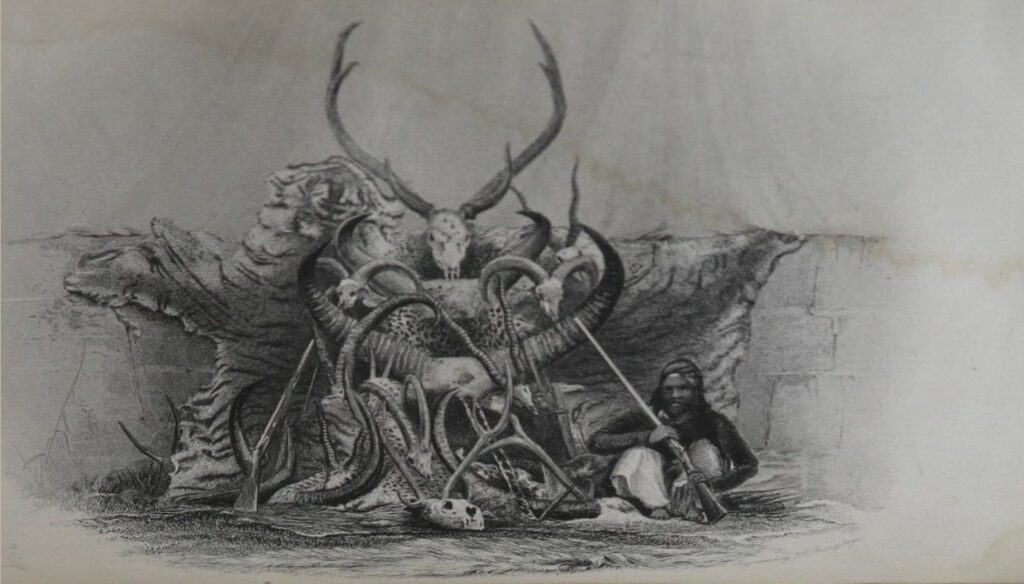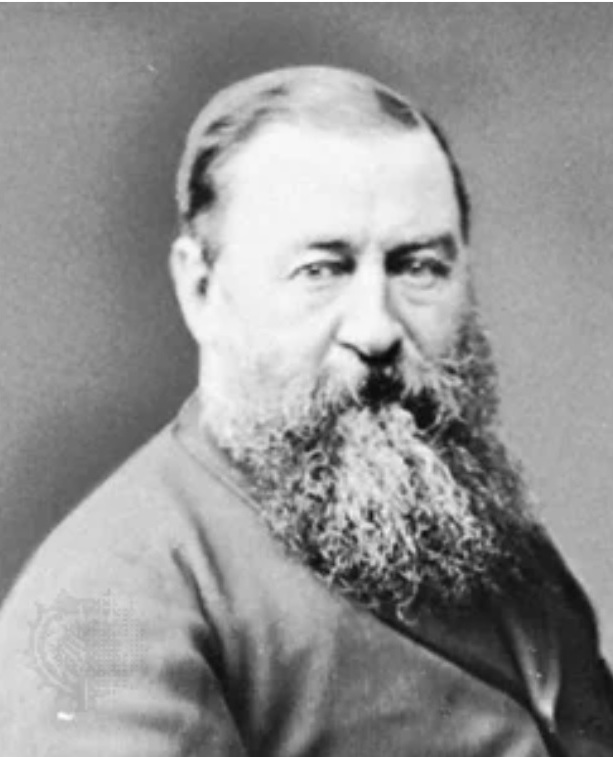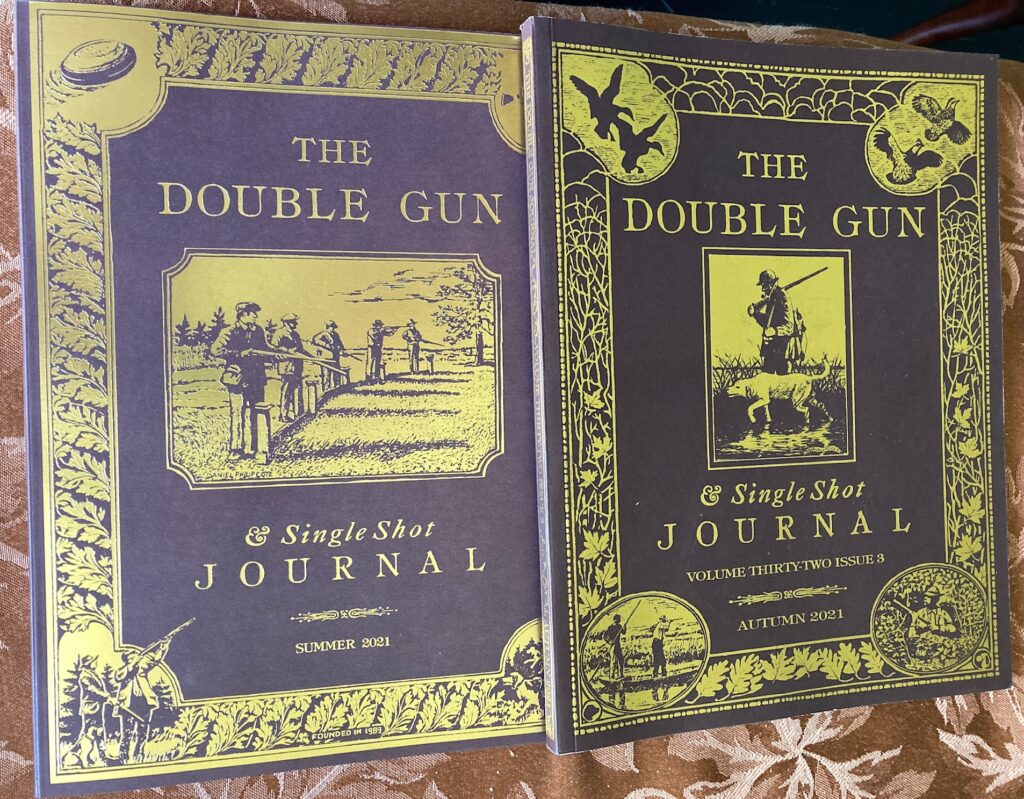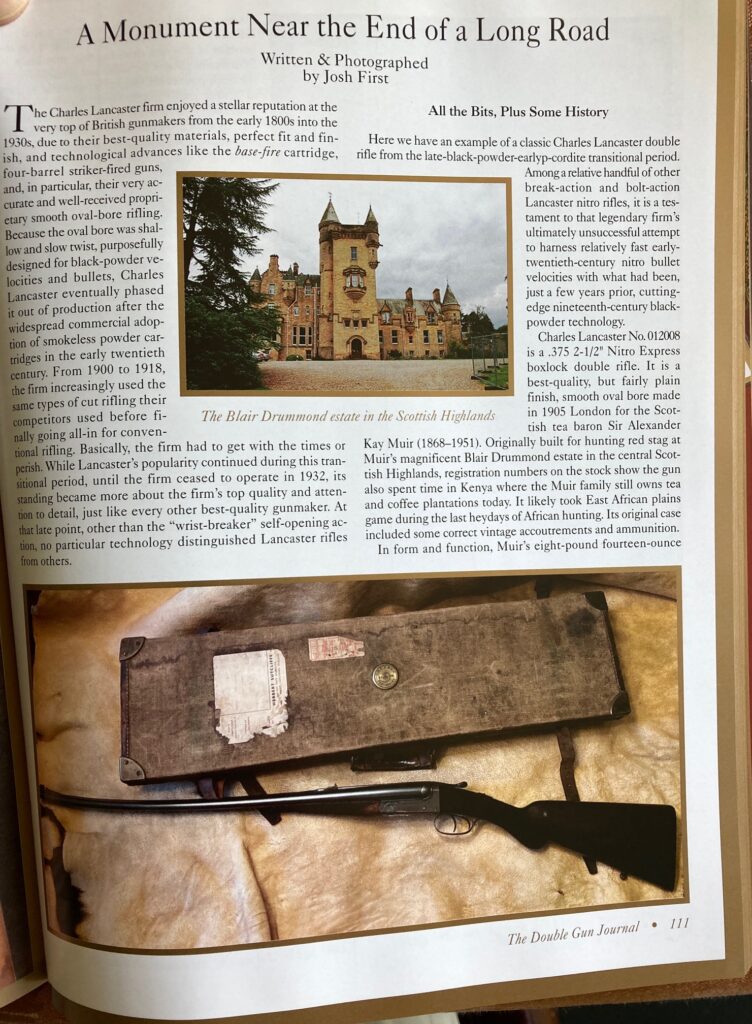Posts Tagged → rifling
American hunters need an accurate round ball shotgun
Lt. James Forsyth wrote a fabulously prescient and useful hunting ballistics book in 1861 from his unique perch in Colonial India, “The Sporting Rifle and its Projectiles.” Using single shot and double barreled muzzleloading rifles, with mere black powder as the propellant, Forsyth squared off against the most dangerous wild animals modern humans have met in battle since the end of the Pleistocene, when our forbears wiped out all of the even more dangerous and ill-tempered megafauna with mere stone tipped spears.
Hold this thought for a minute.
Today’s hunter thinks he needs a soulless, faceless, characterless Three Million Magnum plastic and stainless steel rifle getting 1/8″ accuracy at three miles when topped with the Hubble Telescope, capable of blasting a twelve-inch gaping hole in a steel plate at that same three miles. But the truth is these modern gee-whiz gizmos are dumbing down, blunting, ruining and corrupting the most beautiful, honest, and pure hunting instincts and abilities we have inherited from our fur-clad ancestors.
Sniping animals from impossible distances with weapons they cannot possibly detect or withstand is nothing more than aerial bombing or target shooting at vulnerable living creatures who deserve our greatest respect and admiration, and upon whom we should only inflict our will when we are offensively at their own level of defense.
That is, what honest sport is there in assassinating an unsuspecting wild animal whose honed instincts protect it from every other natural predator, whose own predatory skills must be equally or better honed in order to close the distance and survive another day on the flesh of the prey animal?
What honor is there in these long distance assassinations? I say none.
You say you like to hunt? Okay then, hunt, dammit. Actually hunting means: Get outside on the landscape of your choice and perfect your actual hunting skills. Learn to play the wind, move quietly, use the topography to your advantage, be patient, be attentive, coordinate well with other hunters, and understand the life and habits of your quarry. Then and only then will you be an actual hunter worthy of the honorable name of hunter.
Enough of this hochsitz heated shooting box overlooking a planted field while waiting for some pet buck to step out five minutes before shooting light ends crap. This is not hunting, it is sitting on your lazy ass and relying on high technology to do the real work for you. Unless you are physically disabled or elderly, a status I myself am approaching and fighting hard every step of the way, do not dishonor yourself with this beyond early morning and late afternoon times. Or at least do not dishonor real hunters who actually hunt by calling yourself one of them when you do it exclusively.
Back to Forsyth, who though slight of stature was of immense bravery and manly stoic British character. (Oh, the British…a great people, once, and with some yet living among them who remember the old ways and who could lead their people forward through these dark days…if they would but will it.) Anyhow, Lt. Forsyth was a small but tough little bastard who faced down 8,000-pound rogue elephants, 3,000-pound gaur bison, and 600 pound male tigers, with mere black powder muzzleloading rifles at powder-burn distances.
Regardless of how fatal his shot might be, or not, Forsyth’s hunting adventures were very often enriched by the smell of burning fur as locomotive-powered horns and fangs sped close by him on their way to trying to stamp him into a little red puddle. Gunpowder that is still burning as it exits the gun’s muzzle is likely to catch something on fire if it is close enough, including the hide of charging Death. Forsyth embodied the spirit of the hunter, at least the truly manly hunter willing to take a real risk to gain a genuine and truly earned prize. We who are hunters today must all admire Forsyth, and we must seek to emulate him as much as we can in today’s sad world of toxic femininity and low testosterone. Sniping unsuspecting animals with magnum firepower is gay, or lame, or pathetic; choose your own appropriate adjective, but don’t do it. If Forsyth could trust his life and limb to a round ball, then we can trust our tame deer hunts to it, too.
The singular principle of Forsyth’s sporting rifles (not military weapons, which operate on different principles with different goals) was the use of the round lead ball. Like Sir Samuel Baker in Africa and Ceylon, Forsyth found that large round lead balls sufficiently propelled and accurately placed would utterly crush the life force out of dangerous animals, as well as more demur animals one might simply bag for the pot. Bear in mind again that these two men, in particular Baker, discovered the effectiveness of the round ball by literally shooting dangerous game at such close distances that any small mistake would probably mean life-changing injury or death. They got this close in order to ensure the proper placement of their ball, not to test themselves and see if they could cheat Death.
For mere deer and elk, Baker used a shortened Claymore sword. Yes, he hunted and killed deer species of all sizes (including Highland red stag) by hand, at close quarters combat. So, again, do not lower yourself to shooting unsuspecting animals at long distances with gigantic magnum calibers. Be a man and a hu-man, and get out on the landscape within spitting distance and earn that critter. Archery hunters know and do this innately, and are thus justifiably proud of their kills. Same for traditional muzzleloading hunters, spear chuckers, atl-atl launchers, and handgun hunters.
Today, to implement both Forsyth’s hunting spirit and technological advances in ballistics, so that we might be the best firearm hunters we can possibly be and also be the most practical hunters we can be in an increasingly regulated environment, we need a modern firearm that achieves multiple goals simultaneously.
To that end, I propose the single shot and double barreled shotgun, rifled with Forsyth rifling. Any well made utility grade shotgun will do just fine. Most of the old but trusty utility double barrel shotguns like the Savage Fox Model B or the Stevens Model 311 should take a slight rifling just fine, because their ridiculously thick barrels could be just as easily used to club baby seals as seal the explosive gasses of fired ordnance.
OK, pump and semiauto shotguns could have Forsyth rifled barrels, too. It’s just that our skills improve when we are challenged by (self-imposed) limitations.
Forsyth rifling is specially designed for the round ball at black powder velocities between 1,100 and 1,900 feet per second. This rifling has very shallow depth grooves, like 2/1000 of an inch to 3/1000 of an inch, as well as a very slow twist rate. Like one full turn of the cut rifling in 72-90 inches. With appropriate powder charges in modern steel barrels, either black powder or smokeless powders can be safely used, and both fabulous accuracy and devastating knockdown power achieved. The perfect “brush gun,” at the least.
Using black powder, Forsyth satisfactorily tested his rifling and round balls out to 250 yards, saying that within 150 yards it was exactingly accurate. Probably consistent 1-2 inch groups. With big lead balls. Imagine what can be done using smokeless powder.
To my knowledge, nothing like Forsyth rifling is employed in modern shotguns today. Despite or perhaps because of the ongoing craze for shotguns accurately shooting massive slugs (like TarHunt), sabots, and conicals, it seems the lowly but easily obtained and highly effective round ball has been shelved because too many of them were ineffectively shot at deer and bear out of smoothbore shotguns, or shot out of tightly rifled shotgun barrels designed for conical bullets and sabots.
Round balls have received bad press because here in America they have not been correctly matched with proper rifling except for smaller deer and bear caliber-sized single shot muzzleloading rifles. Time for a change!
One constant and legitimate knock against “punkin balls” is that they were terribly under powered, meant more for imprecise point blank shooting at animals in thick cover. This problem can be easily fixed by correctly loading round balls into shotgun hulls for use in appropriately rifled barrels that will give deadly accuracy and destructive force to round balls. Meaning, add more powder! Pap’s old “punkin balls” would have actually shot incredibly accurately had they gone through barrels with Forsyth rifling.
So let us return to a simpler, cheaper, and frankly more manly and effective firearm: The modern shotgun with Forsyth rifling, designed to very accurately and effectively propel a 20, 16, or 12-guage round lead ball (only 350 to 600 grains weight 😳) around 1,500 feet per second. Put these velocity-times-mass kinetic energy numbers in your pipe and smoke it! You will smoke every deer and bear you hit with such powerful projectiles!
And for those hunters concerned about the cost and availability of hunting projectiles and reloading, there is nothing simpler than pouring your own lead round balls and reloading shotgun hulls. Push come to shove with components, you can most easily obtain lead and black powder, and shotgun hulls are reloadable about twenty times each.
Shooting round balls might feel like going backwards, but in many ways the simpler ways and days were better.
Today I submitted a written request to Henry Repeating Firearms, makers of sturdy, accurate, no-frills shotguns perfect for employing Forsyth rifling, that they please consider undertaking such a project. Let’s say to start, manufacture 100 Forsyth rifling single shot break-action shotguns, tested with correct diameter round balls fired from common shotgun hulls with commonly obtainable smokeless and black powders.
If the 100 single shots sell well, then try a few dozen double barrel shotguns that have received some elementary “regulating” whereby the two barrels are brought into pointing harmony with one another. Each barrel should place its ball at or near the landing point of the other barrel, fully converging together within a 75-120 yard distance.
In conclusion, let us say we pursue this particular goal if not for efficiency, effectiveness, and ease of reloading, then to restore our rightful place and reputation as American riflemen, long hunters, frontiersmen with pluck and the best hunting skills on Planet Earth bar none. Shooting round balls within 200 yards is true fair-chase, ethical hunting.

Lieut. James Forsyth of the British Bengal Riflemen Corps posing with some of his well-earned Asian hunting trophies in about 1860. All of which he took with the black powder round ball. Look at the tiger skull that is the size of Forsyth’s entire chest. Note the tiger skin into which quite a few full-sized Forsyths could be stashed all at one time. We hunters today would do well to use Forsyth’s properly arranged round ball technology.

Sir Samuel Baker, gentleman, ultimate stud, patriot, hunter, fearless adventurer and most tender, devoted, and loving husband to a slave woman he liberated. We should all yearn to be like Sir Samuel in some way or another. Maybe it will just be hunting with a powerful round ball instead of a hyperkinetic missile.
Bidenflation just killed a national publication gem
“Soaring prices of paper, shipping, ink, and printing have put us into the red, and we can no longer function,” reads the personal note I received on a fabulous custom Double Gun Journal card from DGJ proprietors Daniel and Joanna.
What a message: Disastrous loss, beautifully wrapped and delivered on a silver platter.
My first encounter with the DGJ was spring 1991, in Rockville, Maryland, on a Tower Records bookstore shelf, along with Grey’s Sporting Journal and other fancier field sports publications. But the DGJ was different than any other publication I had ever seen, and, therefore, every quarter thereafter I purchased the latest edition and learned about reloading for black powder firearms long believed to be “obsolete” or “dangerous!” or un-sexy enough to compete with modern mass produced plastic and stainless steel firearms lacking a soul, a heart, or even personal appeal.
Distinguished gun and outdoor writers like Ross Seyfried and Sherman Bell introduced modern shooters, antique gun enthusiasts, and financially or historically oriented gun collectors to actually making those beautiful historic firearms shoot once again. Seyfried and Bell, in particular, removed the mystique and veil from antique rifles, double rifles, and double barreled shotguns with Damascus or twist barrels.
It turns out that the beautifully hand crafted double barreled black powder rifles and shotguns of the 1800s, and the early nitro express rifles of the 1900-1930 period, did not just look good. They also shot with incredible precision.
Since the late 1990s I have been an annual subscriber to the DGJ, eagerly awaiting each quarterly installment. In 2017, 2018, and 2022 I published a number of technical articles about Charles Lancaster double rifles. Of particular focus has been the development of Lancaster’s most valuable trademark technology, their singular oval bore rifling. For those with any curiosity, the Lancaster oval bore rifling looks like a smooth shotgun barrel. But if you squint your eyes and look hard enough, you will eventually discern an egg-shaped bore that rotates on a central axis. Lancaster’s proprietary oval bore rifling was long ago, and remains today, one of the great mysteries of sporting arms ballistics, because it absolutely defies physics. And yet, it works incredibly well.
An 1888 Charles Lancaster black powder double rifle that I shoot regularly is capable of placing paper patched bullets from BOTH its barrels into a 1.5″ hole at 100 yards. Now THAT is the very definition of firearm accuracy.
Charles Lancaster oval bore double rifles were The Thing for wealthy sportsmen around the world from the 1850s into the 1920s. That I eventually became the probable “expert” on Charles Lancaster oval bore rifles is due to a simple mistake, or a weird act of Godly intervention, or Fate. Because when now deceased Maine forester extraordinaire Tim Scott asked me to buy his Charles Lancaster .450 BPE double rifle, I bit. And then Ross Seyfried walked me through the steps of making it shoot safely. After that I was hooked, and the rest is history (see also lancasterovalbore.com).
And so here we are, saying goodbye to one of the last, if not THE last artisanal publication in America. A family owned business for decades, a byword and watchword and often the final word on antique firearms technology and reloading, the DGJ is irreplaceable. And yet it too is now fallen victim to Joe Biden’s hyperinflation. Everything is so expensive now, so much more expensive than it was just a year ago.
I recognize that Biden’s purposefully destructive economic policies are aimed at re-setting America into a more communist China-type place. While most Americans oppose this needless, illegal, forced, and destructive change, I think the loss of the DGJ is like the proverbial canary in a coal mine: Its early demise warns of us of coming dangers that can be fatal to us, too.
If you are interested in contacting the DGJ to acquire back issues, binders, beautiful note cards and artwork, etc., they can be reached at 231-536-7439 in central Michigan.

Maybe some day younger Americans will encounter these treasures, and discover an appreciation for fine firearms

My final article in the Double Gun Journal, thanks to Joe Biden’s purposefully destructive economic policies